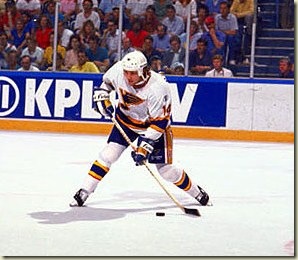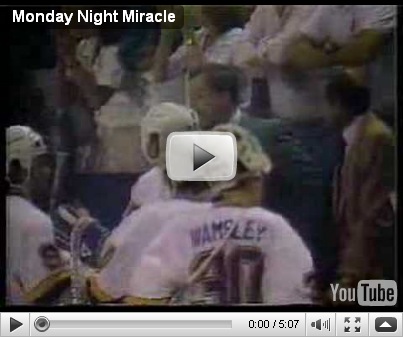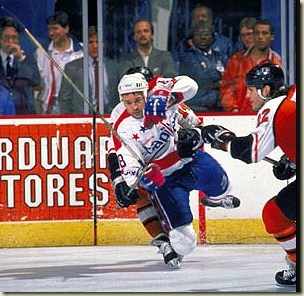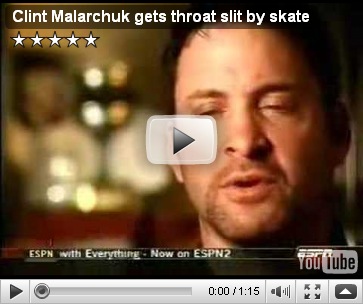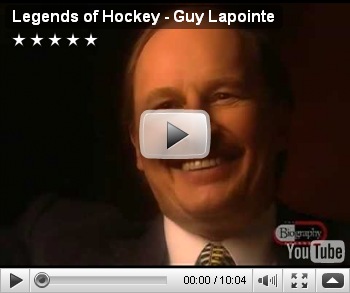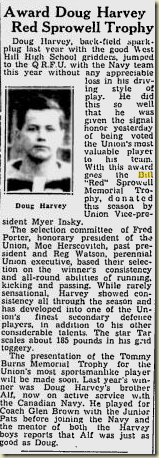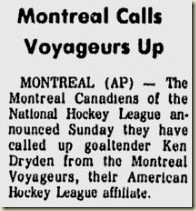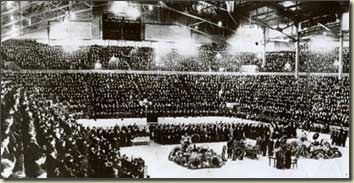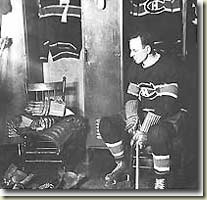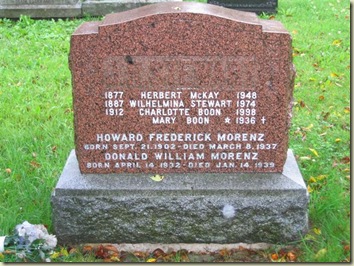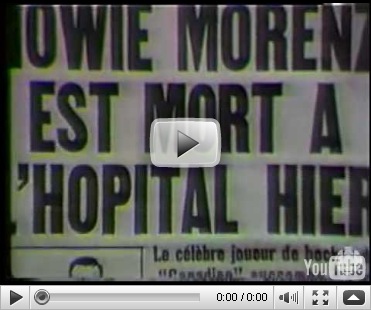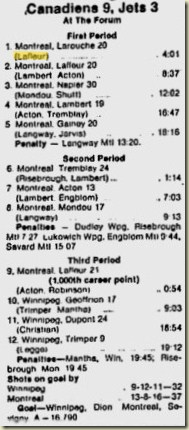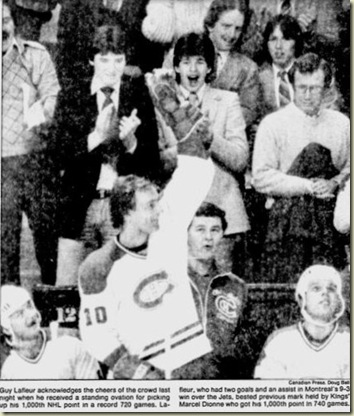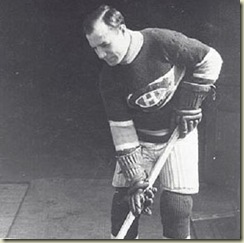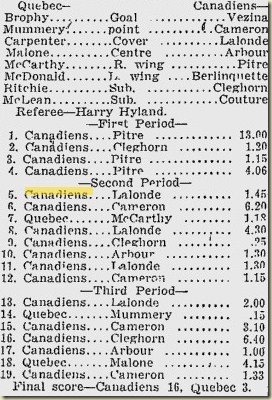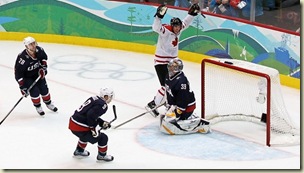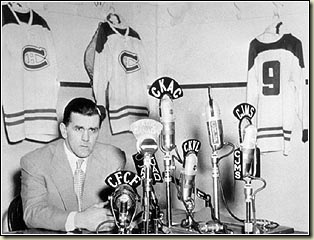 Maurice Richard addresses the people of Quebec 03/18/1955 – HHOF photo
Maurice Richard addresses the people of Quebec 03/18/1955 – HHOF photo
Who would think, outside of the well-known rivalry, that a game between the Montreal Canadiens and the Boston Bruins on March 13, 1955 would result in one of the most infamous incidents in NHL, Quebec and Canadian history?
The 1954-55 season was winding down as Montreal and the Detroit Red Wings were battling for first place in the NHL standings, separated by two points with four games to play. The Bruins were just holding on to the final spot.
The Canadiens and Bruins would play a home-at home series over the weekend of March 13, with Montreal winning the first by a score of 2-1 at the Forum on Saturday.
Canadiens star Maurice “Rocket” Richard went into Sunday’s game leading the league in scoring and closing in on his first Art Ross trophy. Richard was just two points ahead of teammate Bernie Geoffrion and three in front of Jean Beliveau.
With Montreal up 1-0, the Bruins exploded for three goals in the second period, giving them a 3-1 lead heading into the third period.
With around six minutes to play, and with the man advantage, Canadiens coach Dick Irvin decided to pull goaltender Jacques Plante.
After a faceoff, Richard and Bruins forward/defenseman Hal Laycoe raced down the ice after the puck. Laycoe’s stick caught Richard in the head as he raced past the Boston defender near the Bruins’ net.
Referee Frank Udvari signaled for a penalty but let play continue until the 15:11 mark as the Canadiens had maintained possession.

After the whistle blew, Richard was almost to the Boston blueline when he realized he was bleeding from his head. Known for his fiery temper, he turned back and raced to Laycoe, who had already dropped his stick, gloves and eyeglasses that he wore.
Instead of dropping the gloves, Richard laid out a vicious stick swing at Laycoe, striking him across the shoulder and face.
Linesmen Sam Babcock and Cliff Thompson grabbed the players, but Richard broke free. Having had his first stick taken away, Richard found another stick and struck Laycoe two more times. The second blow, over his back, broke the stick.
A second attempt to restrain Richard by Thompson failed, and he again found another stick and struck Laycoe for a fourth time.
Thompson then forced the Canadiens star to the ice, until an unnamed teammate pushed the official away
Dazed and losing blood, Richard got up, grabbed a hold of Thompson and struck him twice in the face along the boards near the Boston bench.
 Linesman Cliff Thompson left the game with a shiner after receiving a pir of punches from Maurice Richard on 03/13/1955 – Montreal Gazette photo
Linesman Cliff Thompson left the game with a shiner after receiving a pir of punches from Maurice Richard on 03/13/1955 – Montreal Gazette photo
Thompson managed to keep his senses and finally got the enraged winger under control. A Canadiens trainer got Richard off the ice and into the first aid room where he received five stitches.
“The left side of his (Richard) face looked like a smashed tomato,” wrote The Montreal Herald’s Vince Lunny. “As Richard skated the length of the ice, the rafters echoed with boos like thunder in a summer sky.”
Udvari issued a game misconduct to Richard for his deliberate attempt to injure and gave Laycoe a five-minute high sticking penalty.
The Bruins forward then received a ten-minute misconduct when he refused to sit down in the penalty box, and threw a towel at Udvari in protest.
Richard only had two words to say on the incident after game, “Ask Laycoe.”
Other counts of the game, mostly in re-enactments and as seen in the 2005 feature film “The Rocket” ,have Richard being restrained by Thompson as Laycoe is allowed to punch him repeatedly. There is no record anywhere that this actually happened.
Laycoe, who had been a teammate of Richard from 1947-1951, laid claim post-game that Richard’s stick had struck him in the head with his stick, in a pitchfork-like manner, first as the two raced for the puck. His statement that it was pitchfork-like may have been embellished as he later testified that he felt a “sudden impact” on his glasses.
A Boston reporter, who chose to remain anonymous in a story issued by the Montreal Gazette on March 18, was the lone supporter of Laycoe’s statement.
“The Rocket checked him, and there isn’t a doubt that his stick came up and flicked Laycoe in the face. As far as I’m concerned, it was strictly an accident. But Laycoe was startled, and his reaction was to swing his stick over the Rocket’s head and open him up.”
There was also a previous altercation between the two at 4:45 of the first period, when Laycoe served a minor penalty for charging and upending Richard.
Once things settled on the ice, the Canadiens managed to score in the final minute but lost the game 4-2.

In a rare photo from March 13, 1955, the Canadiens Bert Olmstead and linesman Cliff Thompson restrain the Bruins Hal Laycoe. Montreal’s Jean Beliveau is in the foreground holding back the Bruins Fleming Mackell. Maurice Richard is out of sight behind the two groups. – Photo: Corbis.com
As the Canadiens prepared to depart for the trip home, two Boston police officers arrived at the dressing room door, seeking to charge Richard with assault and battery with a dangerous weapon. Irwin, and likely several teammates blocked their path as an argument began.
The officers left without any incident after learning from Bruins president Walter Brown and GM Lynn Patrick would take up the the issue with NHL president Clarence Campbell. The league would schedule a hearing at it’s Montreal office on March 16.
On the way home from Boston, Richard had been suffering headaches but said nothing. At the Canadiens practice the following Monday, coach Dick Irwin noted his star player looked pale. Richard told him of the headaches and that he had not slept all night still not 100% and sent him to the hospital for further examination and x-rays.
Irwin was also highly critical of the officiating over the weekend (Udvari refereed both games) and that perhaps the incident could have been prevented.
“The game in Boston was badly handled,” Irwin said. “I’ve been in hockey a long time, and one thing I’ve noticed on the ice is that there are never any brawls on the ice when the officiating is good.
“Thompson took a flying leap at him (Richard) and knocked him to the ice. That sort of stuff (violent force) is against a league directive.”
Irwin had asked both linesman which player had possession when the initial high sticking incident occurred. Both said Laycoe, and the Bruins' player’s testimony three days later would be in agreement with that of the officials.
So if Laycoe indeed had the puck, immediately after striking Richard, why did Uvardi not blow the whistle sooner?
In defense of his player’s assault on the linesman, Irwin said that Richard had lost nearly a pint of blood from his injury and his face was covered with it when he struck Thompson.
“It was pouring down his face. How was the Rocket to know if it was an official or a Boston player?” he said. “I don’t believe Richard knew it was the linesman he struck”
In Boston, reports were that Brown and Patrick wanted Richard banned for life for the altercation.
“I personally see no alternative for Campbell other than immediate suspension at least the rest of the year, including the playoffs,” said Patrick. “With the playoffs coming up, I don’t see how Campbell can stickhandle around that.”
Other Boston writers laid claim that Patrick would rather not see Richard suspended immediately, possibly fearing poor playoff attendance, and suspend him for the entire following season.
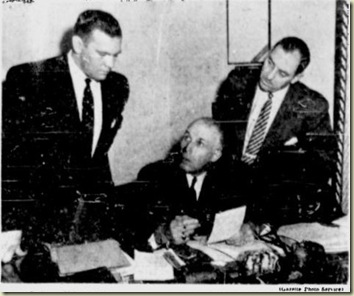 NHL president Clarence Campbell (center) meets with referee Frank Udvari (left) and referee-in-chief Carl Voss 03/15/55 – Montreal Gazette Photo
NHL president Clarence Campbell (center) meets with referee Frank Udvari (left) and referee-in-chief Carl Voss 03/15/55 – Montreal Gazette Photo
With the Rocket cleared by doctors, the hearing in Campbell’s office took place as scheduled on the 16th. Richard, Irvin, assistant GM Ken Reardon (in attendance for GM Frank Selke) represented the Canadiens. Brown, Patrick, Laycoe and coach Jack Adams were the Bruins reps. All three officials from Sundays game attended, as well as referee-in-chief Carl Voss.
After six hours of taking in testimony, as well as looking at Richard’s prior track record of incidents with players and officials, the most recent coming in December of 1954, Campbell made his decision.
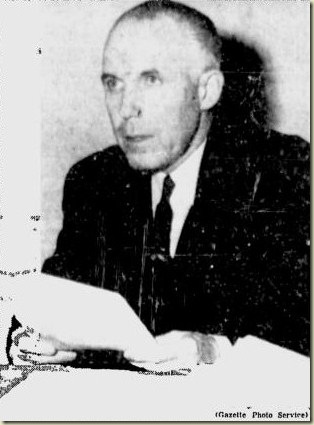 Clarence Campbell announces the suspension of Maurice Richard 03/16/1955 – Montreal Gazette photo
Clarence Campbell announces the suspension of Maurice Richard 03/16/1955 – Montreal Gazette photo
He suspended the Canadiens star for the remainder of the season and the playoffs, sending massive shock and protest across Montreal and Quebec.
The aftermath would peak the next night, when Campbell boldly appeared at the Canadiens/Red Wings match at the Forum.
Did you know?: In the 2005 feature film “The Rocket”, the role of the Bruins Hal Laycoe was played by former Canadiens defenseman Mathieu Dandineault. An interview with Dandineault, by the Montreal Gazette, on his part in the filming can be found here.
Laycoe’s playoff police escort: After the Richard Riot’s settled, the Bruins faced the Canadiens in the semi-finals. Laycoe was still non-favourable in the eyes of the Canadiens fans.
''I drew Laycoe as my taxi teammate. When we got to the Forum, the police were waiting for us,” said Laycoe’s teammate Ed Sandford. “They escorted us into the building and to the dressing room past a bunch of angry fans. Then every time Laycoe came on the ice, the crowd booed him.''
Resources for this story:
Books:
Coleman, Charles; The Trail of the Stanley Cup Vol. 3
Denault, Todd; Jacques Plante: The Man who Changed the Face of Hockey
Jenish, D’Arcy: The Montreal Canadiens: 100 Years of Glory
McFarlane, Brian: True Hockey Stories: The Habs
Online:
HabsEyesOnthePrize.com
Corbis.com
Google News Archives (Montreal Gazette Mar 14-18, 1955)




